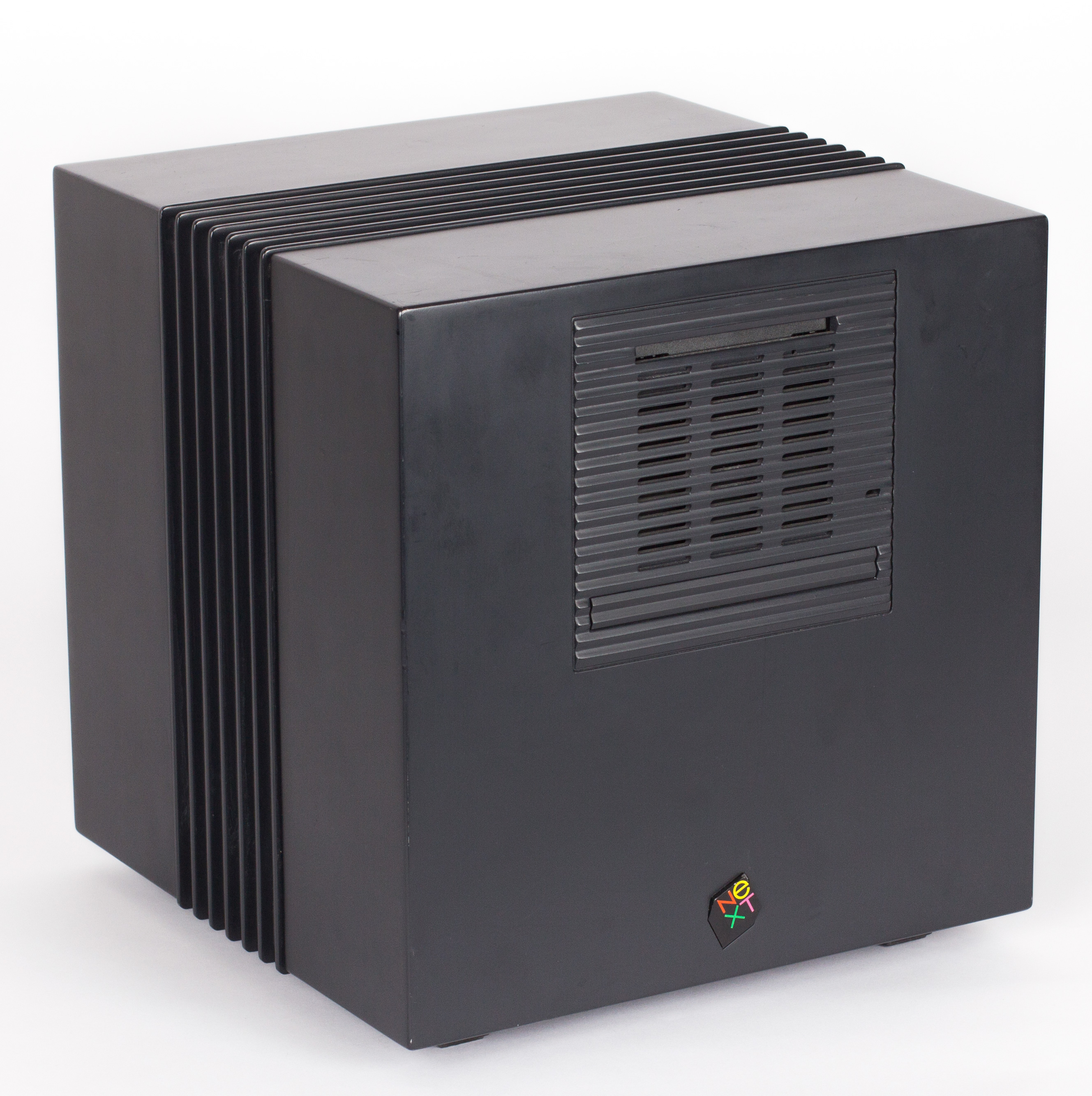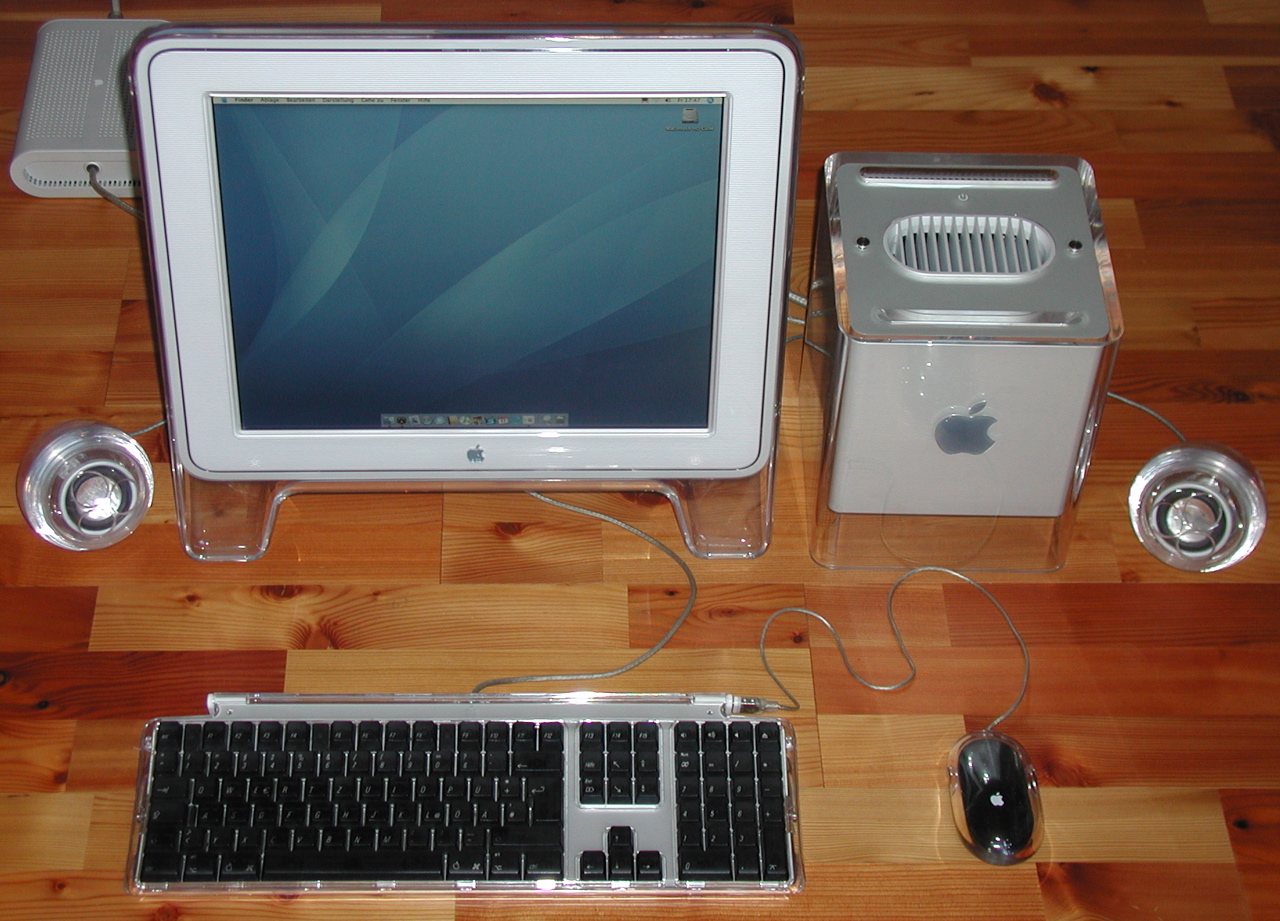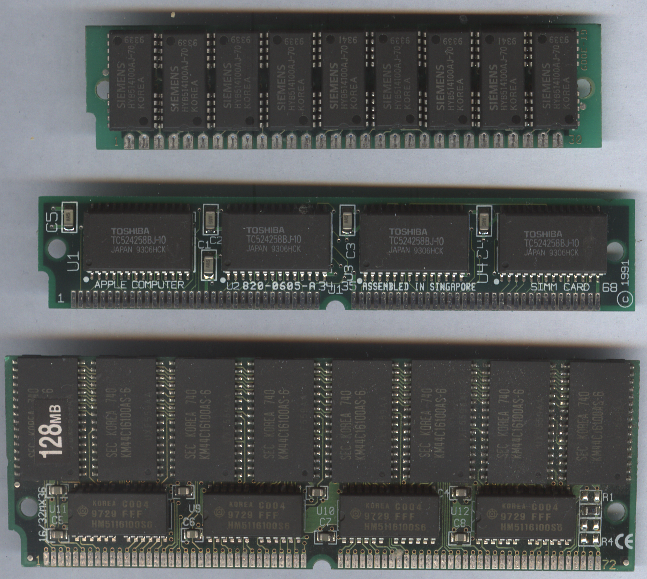|
NeXTcube Turbo
The NeXTcube Turbo is a high-end workstation computer developed, manufactured and sold by NeXT. It superseded the earlier NeXTcube workstation and is housed in the same cube-shaped magnesium enclosure. It runs the NeXTSTEP operating system. Hardware The NeXTcube Turbo is a development of the earlier NeXTcube. It differs from its predecessor in having a 33 MHz 68040 processor. The NeXTdimension board can also be used in the NeXTcube Turbo. There was also a very rare accelerator board known as the Nitro; between 5 and 20 are estimated to have been made. It increased the speed of a NeXTcube Turbo by replacing the standard 33 MHz processor with a 40 MHz one. Specifications * Display: 1120×832 17" grayscale MegaPixel Display * Operating system: NeXTSTEP, OPENSTEP * CPU: 33 MHz 68040 with integrated floating-point unit * Digital signal processor: 25 MHz Motorola DSP56001 * RAM: 16 MB, expandable to 128 MB (Four 72-pin SIMM slots) * Floppy Drive: 2.8 ... [...More Info...] [...Related Items...] OR: [Wikipedia] [Google] [Baidu] |
NeXTcube
The NeXTcube is a high-end workstation computer developed, manufactured, and sold by NeXT from 1990 to 1993. It superseded the original NeXT Computer workstation and is housed in a similar cube-shaped magnesium enclosure, designed by frog design. The workstation runs the NeXTSTEP operating system and was launched with a list price. Hardware The NeXTcube is the successor to the original NeXT Computer, with a 68040 processor, a hard disk in place of the magneto-optical drive, and a floppy disk drive. NeXT offered a 68040 system board upgrade (and NeXTSTEP 2.0) for . A 33 MHz NeXTcube Turbo was later produced. NeXT released the NeXTdimension for the NeXTcube, a circuit board based on an Intel i860 processor, which offers 32-bit PostScript color display and video-sampling features. The Pyro accelerator board replaces the standard 25 MHz processor with a 50 MHz one. Specifications * Display: 1120×832 17 in (432 mm) 82 ppi grayscale MegaPixel Display * O ... [...More Info...] [...Related Items...] OR: [Wikipedia] [Google] [Baidu] |
Operating System
An operating system (OS) is system software that manages computer hardware and software resources, and provides common daemon (computing), services for computer programs. Time-sharing operating systems scheduler (computing), schedule tasks for efficient use of the system and may also include accounting software for cost allocation of Scheduling (computing), processor time, mass storage, peripherals, and other resources. For hardware functions such as input and output and memory allocation, the operating system acts as an intermediary between programs and the computer hardware, although the application code is usually executed directly by the hardware and frequently makes system calls to an OS function or is interrupted by it. Operating systems are found on many devices that contain a computerfrom cellular phones and video game consoles to web servers and supercomputers. , Android (operating system), Android is the most popular operating system with a 46% market share, followed ... [...More Info...] [...Related Items...] OR: [Wikipedia] [Google] [Baidu] |
History Of The Internet
The history of the Internet originated in the efforts of scientists and engineers to build and interconnect computer networks. The Internet protocol suite, Internet Protocol Suite, the set of rules used to communicate between networks and devices on the Internet, arose from research and development in the United States and involved international collaboration, particularly with researchers in the United Kingdom and France. Computer science was an emerging discipline in the late 1950s that began to consider time-sharing between computer users, and later, the possibility of achieving this over wide area networks. J. C. R. Licklider developed the idea of a universal network at the Information Processing Techniques Office (IPTO) of the United States United States Department of Defense, Department of Defense (DoD) DARPA, Advanced Research Projects Agency (ARPA). Independently, Paul Baran at the RAND Corporation proposed a distributed network based on data in message blocks in the ea ... [...More Info...] [...Related Items...] OR: [Wikipedia] [Google] [Baidu] |
Computer Workstations
A workstation is a special computer designed for technical or scientific applications. Intended primarily to be used by a single user, they are commonly connected to a local area network and run multi-user operating systems. The term ''workstation'' has been used loosely to refer to everything from a mainframe computer terminal to a PC connected to a network, but the most common form refers to the class of hardware offered by several current and defunct companies such as Sun Microsystems, Silicon Graphics, Apollo Computer, DEC, HP, NeXT, and IBM which powered the 3D computer graphics revolution of the late 1990s. Workstations formerly offered higher performance than mainstream personal computers, especially in CPU, graphics, memory, and multitasking. Workstations are optimized for the visualization and manipulation of different types of complex data such as 3D mechanical design, engineering simulations like computational fluid dynamics, animation, video editing, image editi ... [...More Info...] [...Related Items...] OR: [Wikipedia] [Google] [Baidu] |
Power Mac G4 Cube
The Power Mac G4 Cube is a Mac personal computer sold by Apple Computer, Inc. between July 2000 and 2001. The Cube was conceived as a miniaturized but powerful computer by Apple chief executive officer ( CEO) Steve Jobs and designed by Jony Ive. Apple developed new technologies and manufacturing methods for the product—a cubic computer housed in clear acrylic glass. Apple positioned it in the middle of its product range, between the consumer iMac G3 and the professional Power Mac G4. The Cube was announced at the Macworld Expo on July 19, 2000. The Cube won awards and plaudits for its design upon release, but reviews noted its high cost compared to its power, its limited expandability, and cosmetic defects. The product was an immediate commercial failure, with only 150,000 units sold before production was suspended within one year of its announcement. The Cube is one of the rare failures for the company under Jobs, after having avoided bankruptcy. However, it influenc ... [...More Info...] [...Related Items...] OR: [Wikipedia] [Google] [Baidu] |
NeXT Character Set
The NeXT character set (often aliased as NeXTSTEP encoding vector, WE8NEXTSTEP or next-multinational) was used by the NeXTSTEP and OPENSTEP operating systems on NeXT workstations beginning in 1988. It is based on Adobe Systems' PostScript (PS) character set aka '' Adobe Standard Encoding'' where unused code points were filled up with characters from ISO 8859-1 (Latin 1), although at differing code points. Character set The following table shows the NeXT character set. Each character is shown with a potential Unicode equivalent. Codepoints 00hex (0) to 7Fhex (127) are nearly identical to ASCII. See also *Display PostScript Display PostScript (or DPS) is a 2D graphics engine system for computers that uses the PostScript (PS) imaging model and language to generate on-screen graphics. PS was originally developed for computer printing, to which DPS adds a number of fe ... (DPS) Footnotes References {{Character encoding NeXT Character sets ... [...More Info...] [...Related Items...] OR: [Wikipedia] [Google] [Baidu] |
NeXTstation
NeXTstation is a high-end workstation computer developed, manufactured, and sold by NeXT from 1990 until 1993. It runs the NeXTSTEP operating system. The system was designed to be a lower-cost option compared to the company's upscale product, the NeXTcube. Compared to the cube, it removed a number of features and had limited expandability, allowing it to fit in a much smaller pizza-box form factor case. There were two major series of the system released during its production run. The initial models were the NeXTstation and NeXTstation Color. Both were based on the Motorola 68040 processor running at 25 MHz. The Color units supported 12-bit color graphics (4,096 colors) stored in a separate 1.5 MB VRAM memory. Turbo versions were released in April 1992, which increased the speed of the processor to 33 MHz and increased the maximum amount of main memory from 32 to 128 MB of RAM. Both the station and the cube initially used the same displays, the original ... [...More Info...] [...Related Items...] OR: [Wikipedia] [Google] [Baidu] |
NeXT Computer
NeXT Computer (also called the NeXT Computer System) is a workstation computer that was developed, marketed, and sold by NeXT Inc. It was introduced in October 1988 as the company's first and flagship product, at a price of , aimed at the higher-education market. It was designed around the Motorola 68030 CPU and 68882 floating-point coprocessor, with a clock speed of . Its NeXTSTEP operating system is based on the Mach microkernel and BSD-derived Unix, with a proprietary GUI using a Display PostScript-based back end. According to the Science Museum Group, "The enclosure consists of a 1-foot () die-cast magnesium cube-shaped black case, which led to the machine being informally referred to as 'The Cube'." The NeXT Computer was renamed NeXTcube in a later upgrade. The NeXTstation, a more affordable version of the NeXTcube, was released in 1990. Launch The NeXT Computer was launched in October 1988 at a lavish invitation-only event, " NeXT Introduction – the Introdu ... [...More Info...] [...Related Items...] OR: [Wikipedia] [Google] [Baidu] |
NuBus
NuBus () is a 32-bit parallel computer bus, originally developed at MIT during between 1978 and 1979 as part of the NuMachine workstation project, it would subsequently be standardized by the IEEE in 1987. The first complete implementation of the NuBus was done by Western Digital for their NuMachine, and for the Lisp Machines Inc. LMI Lambda. The NuBus was later incorporated in Lisp products by Texas Instruments (Explorer), and used as the main expansion bus by Apple Computer and a variant called NeXTBus was developed by NeXT. It is no longer widely used outside the embedded market. Architecture Early microcomputer buses like S-100 were often just connections to the pins of the microprocessor and to the power rails. This meant that a change in the computer's architecture generally led to a new bus as well. Looking to avoid such problems in the future, NuBus was designed to be independent of the processor, its general architecture and any details of its I/O handling. ... [...More Info...] [...Related Items...] OR: [Wikipedia] [Google] [Baidu] |
SCSI
Small Computer System Interface (SCSI, ) is a set of standards for physically connecting and transferring data between computers and peripheral devices, best known for its use with storage devices such as hard disk drives. SCSI was introduced in the 1980s and has seen widespread use on servers and high-end workstations, with new SCSI standards being published as recently as SAS-4 in 2017. The SCSI standards define commands, protocols, electrical, optical and logical interfaces. The SCSI standard defines command sets for specific peripheral device types; the presence of "unknown" as one of these types means that in theory it can be used as an interface to almost any device, but the standard is highly pragmatic and addressed toward commercial requirements. The initial Parallel SCSI was most commonly used for hard disk drives and tape drives, but it can connect a wide range of other devices, including scanners and optical disc drives, although not all controllers can handle ... [...More Info...] [...Related Items...] OR: [Wikipedia] [Google] [Baidu] |
SIMM
A SIMM (single in-line memory module) is a type of memory module used in computers from the early 1980s to the early 2000s. It is a printed circuit board upon which multiple random-access memory Integrated circuit chips are attached to one or both sides. It differs from a dual in-line memory module (DIMM), the most predominant form of memory module since the late 1990s, in that the contacts on a SIMM are redundant on both sides of the module. SIMMs were standardised under the JEDEC JESD-21C standard. Most early PC motherboards ( 8088-based PCs, XTs, and early ATs) used socketed DIP chips for DRAM. As computer memory capacities grew, memory modules were used to save motherboard space and ease memory expansion. Instead of plugging in eight or nine single DIP chips, only one additional memory module was needed to increase the memory of the computer. History SIMMs were invented in 1983 by James E. ClaytonClayton, James E. (1983)Low-cost, high-density memory packaging: A 64K ... [...More Info...] [...Related Items...] OR: [Wikipedia] [Google] [Baidu] |
Digital Signal Processor
A digital signal processor (DSP) is a specialized microprocessor chip, with its architecture optimized for the operational needs of digital signal processing. DSPs are fabricated on metal–oxide–semiconductor (MOS) integrated circuit chips. They are widely used in audio signal processing, telecommunications, digital image processing, radar, sonar and speech recognition systems, and in common consumer electronic devices such as mobile phones, disk drives and high-definition television (HDTV) products. The goal of a DSP is usually to measure, filter or compress continuous real-world analog signals. Most general-purpose microprocessors can also execute digital signal processing algorithms successfully, but may not be able to keep up with such processing continuously in real-time. Also, dedicated DSPs usually have better power efficiency, thus they are more suitable in portable devices such as mobile phones because of power consumption constraints. DSPs often use special m ... [...More Info...] [...Related Items...] OR: [Wikipedia] [Google] [Baidu] |








